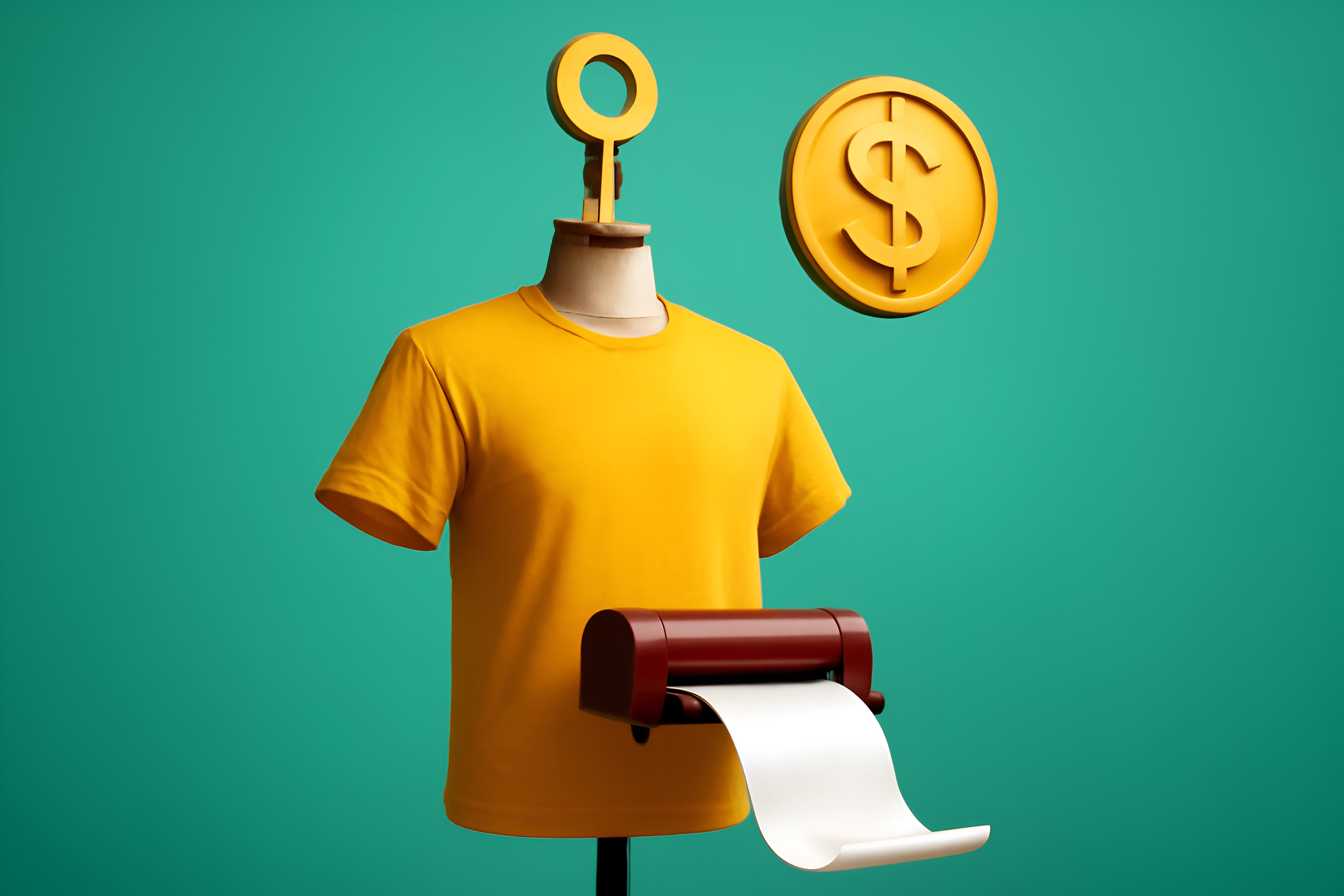
You’ve heard the promise, haven’t you? The dream of passive income, where money flows into your account while you sleep, travel, or simply live your life. But for so many, the reality is a crushing disappointment—a "passive" venture that quickly becomes a second, more demanding job, constantly begging for your attention.
The dream isn't a lie, but it has been misunderstood. True financial freedom isn't about finding a magic money button; it's about building a system. It's about creating an asset that works tirelessly for you, long after your initial effort is spent. This is where Print-on-Demand (POD) enters the picture, not as just another side hustle, but as a powerful vehicle for building real, recurring revenue.
Forget what you think you know about selling t-shirts online. This is not a guide to chasing fleeting trends or making a few quick bucks. This is your strategic blueprint for turning your creativity into a reliable, automated income engine—a system designed to generate sales for years, not just weeks.
What is Print-On-Demand (and Why It’s a Perfect Model for Recurring Revenue)
Let's cut through the noise. The Print-on-Demand model is brilliantly simple: you create a design, upload it to a product (like a t-shirt, mug, or poster), and list it for sale in an online store. When a customer buys it, a partner company like Printful automatically prints, packages, and ships the product directly to them. You never touch inventory, handle shipping, or pay for a product until you've already made a sale.
This is where the "passive" potential truly shines. Let's be clear: passive does not mean zero work. It means the work is heavily front-loaded. You invest your time and energy upfront in research, design, and setup. Once that's done, the automated system takes over, fulfilling orders and handling customer service, freeing you from the daily grind.
The key differentiator that makes this a perfect model for recurring revenue is the asymmetry of your effort. Unlike freelancing, where you trade an hour of your time for a fixed payment, a single, well-crafted design is an asset that can sell hundreds or even thousands of times with no additional creative work per sale. This is the very core of a successful print on demand passive income strategy, allowing you to build a scalable business without the traditional risks.
The Foundation: Your 4-Step Blueprint for a Profitable POD Business
Building a business that lasts requires a foundation of stone, not sand. Rushing this stage is the number one reason most POD stores fail. Follow these four steps methodically, and you'll be building an asset designed for longevity and profit.
Step 1: Find Your Evergreen Niche, Not Just a Passing Trend
Your first, most critical decision is choosing your battlefield. A trend, like a viral meme or a political slogan, offers a quick spike in sales followed by a swift crash. An evergreen niche, however, is built on a deep, sustained passion—think hiking, knitting, dog agility training, or specific professions like nursing or engineering. These communities have year-round buying triggers and a built-in desire for products that reflect their identity.
How do you find one? Start by brainstorming your own passions and hobbies. Then, use a tool like Google Trends to validate their long-term interest; a stable or upward-trending line over five years is a fantastic sign. A search for "minimalist cat art" will show far more stability than a fleeting pop culture reference, revealing a profitable niche with lasting power.
Finally, immerse yourself in these communities on platforms like Etsy and Pinterest. Look for recurring themes, inside jokes, and shared values. You aren't just looking for a topic; you're looking for a tribe you can serve, a group of people whose passion provides a constant source of demand for your future products.
Step 2: Validate Your Niche with Smart Research
An idea is not an opportunity until it's validated. Once you have a potential niche, you must confirm that people are actively spending money there and that there's room for you to compete. Start by searching for phrases like gifts for [niche] or [niche] shirt on marketplaces like Etsy.
Are there already best-sellers? That's a good thing—it proves demand. Now, ask the crucial question: can you do better? Perhaps the existing designs are low-quality, the humor is generic, or they're missing a specific sub-niche, like "funny mugs for organic chemists." This is your opening.
According to a case study from Printful, the brand UMAI Clothing achieved a staggering $130,000 in monthly revenue by targeting the underserved niche of Japanese streetwear enthusiasts. They didn't invent a market; they found a passionate, existing one and served it better than anyone else. Your goal is to find a similar gap where your quality and focus can shine.
Step 3: Choose Your Platform(s): Marketplace vs. Your Own Store
Where you sell your products will define your marketing strategy. You have two primary paths: leveraging a marketplace or building your own branded store. Each has distinct advantages for someone looking to build recurring revenue with print on demand.
Marketplaces like Etsy have a massive, built-in audience actively searching for products. This is a huge advantage for beginners, as you can tap into organic traffic from day one. The trade-off is higher competition, transaction fees, and less control over your brand's presentation.
Building your own store with a platform like Shopify, integrated with a service like Printify or Printful, gives you total control. You build a true brand asset, capture customer emails, and enjoy higher profit margins. The challenge? You are responsible for generating 100% of your traffic. For this reason, we recommend a hybrid approach: start on Etsy to validate your designs and find your best-sellers with minimal risk. Once you have proven winners, migrate them to your own Shopify print-on-demand store to build a long-term, defensible brand.
Step 4: Define Your Simple Brand Identity
Branding isn't about spending thousands on a fancy logo. For a POD business, a strong brand is simply about consistency. It's the cohesive style, voice, and customer focus that makes your shop instantly recognizable and encourages repeat purchases.
This could be as simple as a consistent color palette, a specific font you use in all your text-based designs, or a unique voice in your product descriptions. Are you witty and sarcastic? Inspirational and uplifting? Your brand identity should be a direct reflection of the niche you serve.
Services like Printful even allow for white-labeling, meaning you can add a custom logo to your packaging and include branded pack-in slips. This transforms a generic transaction into a memorable brand experience, turning a one-time buyer into a loyal fan. This simple touch is one of the most overlooked recurring revenue strategies in the POD world.
The Creative Engine: Designing Products That Sell on Autopilot
Your designs are the heart of your business. But creative genius isn't what sells—clarity and connection do. The most successful POD products are often the simplest, resonating with a customer's identity on an emotional level.
The Anatomy of a Winning Design
Look at the best-sellers in any evergreen niche. You'll rarely find complex, multi-colored masterpieces. What you will find are clean, simple, and instantly understandable designs: bold text-based phrases, relatable quotes, and minimalist graphics that speak directly to the target audience. A shirt that says I'd Rather Be Hiking doesn't need a photorealistic mountain range; the words themselves create the connection.
Focus 80% of your creative energy on these evergreen concepts that will sell year-round. Dedicate the remaining 20% to seasonal or trending topics (like "Christmas Gifts for Dog Lovers") to capture short-term traffic boosts. This balanced approach ensures a steady stream of sales while still allowing you to capitalize on timely events.
When creating your designs, remember that simplicity ensures high-quality printing across a range of products. A clean vector graphic made in a program like Adobe Illustrator will look just as good on a small mug as it will on a large hoodie.
Tools of the Trade for Every Budget
You don't need to be a professional graphic designer to create products that sell. A new wave of user-friendly tools has leveled the playing field.
For beginners, platforms like Canva and Kittl offer thousands of templates, fonts, and AI-powered tools that allow you to create professional-grade designs in minutes. For those who want more control, industry-standard software like Adobe Illustrator or the affordable alternative Affinity Designer provide limitless creative freedom. The key is to choose a tool and master it.
One final, crucial note on design. Before you create anything, you must protect your business by checking for intellectual property infringement.
Always check the USPTO's TESS database for trademarks on any phrase you plan to use. When in doubt, leave it out.Getting your account shut down for a copyright violation is the fastest way to kill your passive income dream. Be smart and create original work.
The System: How to Build Recurring Revenue with Print on Demand
This is where we separate the hobbyists from the earners. To build a truly passive income stream, you must stop thinking about selling individual products and start thinking about building automated systems that generate sales for you.
Strategy 1: Master Platform SEO
Your product listings are your digital salespeople, working 24/7 to bring in customers. Search Engine Optimization (SEO) is how you train them to be effective. On a marketplace like Etsy, this means using the exact keywords your customers are searching for in your titles, descriptions, and tags. According to e-commerce experts, sellers who use all 13 available tags on their Etsy listings see dramatically more organic traffic than those who don't.
For your own Shopify store, the principles are the same but applied more broadly. You'll optimize product pages, write blog posts that answer your niche's questions (e.g., "Top 10 Gifts for Book Lovers"), and ensure your images have descriptive alt-text. This is the number one driver of free, organic, and passive sales.
Strategy 2: Build Cohesive Collections
Don't just throw random designs at the wall to see what sticks. Group your products into logical, cohesive collections. A customer who loves your "Minimalist Nurse Humor" t-shirt is highly likely to also be interested in a matching tote bag or mug.
By creating collections, you position your shop as the go-to destination for that specific interest. This strategy dramatically increases your average order value and customer lifetime value. In fact, data suggests that stores with well-curated collections can achieve a significantly higher conversion rate than shops with a chaotic mix of unrelated products.
Strategy 3: Leverage a "Slow Burn" Marketing Channel
Aggressive, time-intensive marketing is the enemy of passive income. Instead, focus on a "slow burn" channel that delivers compounding returns over time. For a visual business like POD, there is no better platform than Pinterest.
Unlike a tweet or an Instagram post that has a lifespan of a few hours, a single Pin can continue to drive traffic to your product for months or even years. The plan is simple: for every new product you list, create 3-5 compelling, vertical pins with keyword-rich descriptions. This builds a vast, interconnected web of traffic that works for you long after you've pinned it, making it a cornerstone of any effective print on demand business guide.
Strategy 4: Encourage Repeat Customers
The easiest and most profitable sale you will ever make is to a happy existing customer. You must have a system in place to encourage them to come back. This can be as simple as including a thank you note with a discount code for their next purchase, a feature easily automated within your Printful account settings.
This simple act does more than just drive another sale; it builds loyalty and transforms a customer into an advocate for your brand. It's a small detail that creates a powerful, recurring revenue loop, turning one sale into two, three, or more over time.
Scaling Your POD Empire: From Side Hustle to Serious Income
Once your system is in place and generating consistent, passive income, it's time to think bigger. For the truly ambitious earner, this foundational income stream is just the beginning. Here’s how you level up.
Expand Your Product Catalog and Ad Spend
The first step in scaling is simple leverage. Take your proven, best-selling designs and expand them across a wider range of products. That winning t-shirt slogan can become a best-selling hoodie, tote bag, and phone case with just a few clicks, instantly multiplying your potential revenue streams.
Once you have a clear best-seller that is converting well organically, it's time to pour a little fuel on the fire. Reinvest a small portion of your profits into targeted ads on Etsy or Pinterest. By promoting a product you know already sells, you aren't gambling; you're making a calculated investment to scale your sales and reach a much larger audience.
Build Your Own Brand Asset on Shopify
The ultimate goal for any serious POD entrepreneur is to own the platform and the customer relationship. As your marketplace sales grow, begin migrating your top-performing products to your own Shopify store. This move is critical for long-term growth.
Owning your store allows you to capture customer emails, build a direct line of communication for future promotions, and create a defensible brand that isn't subject to the whims of a marketplace's algorithm. This is how you transition from simply earning money online to building a valuable, sellable business asset, a path followed by top sellers like Mandy Dobosenski, who scaled her POD business to over $500,000 by expanding from Etsy to her own branded channels.
Conclusion: Your First Step Towards Automated Income
True, sustainable passive income from print-on-demand is not born from luck or a single viral design. It is the direct result of building a deliberate, intelligent system. The formula is proven and repeatable: a timeless Evergreen Niche, combined with Quality Designs, amplified by Platform SEO, and sustained by Slow-Burn Marketing.
The journey to financial freedom is built one system at a time, one asset at a time. You now have the complete blueprint to build an income stream that can pay you back for years to come, freeing up your time and energy for what truly matters. The only thing left is to take the first step.
What's one evergreen niche you're passionate about? Share your idea in the comments below—declaring it is the first step to making it real.














